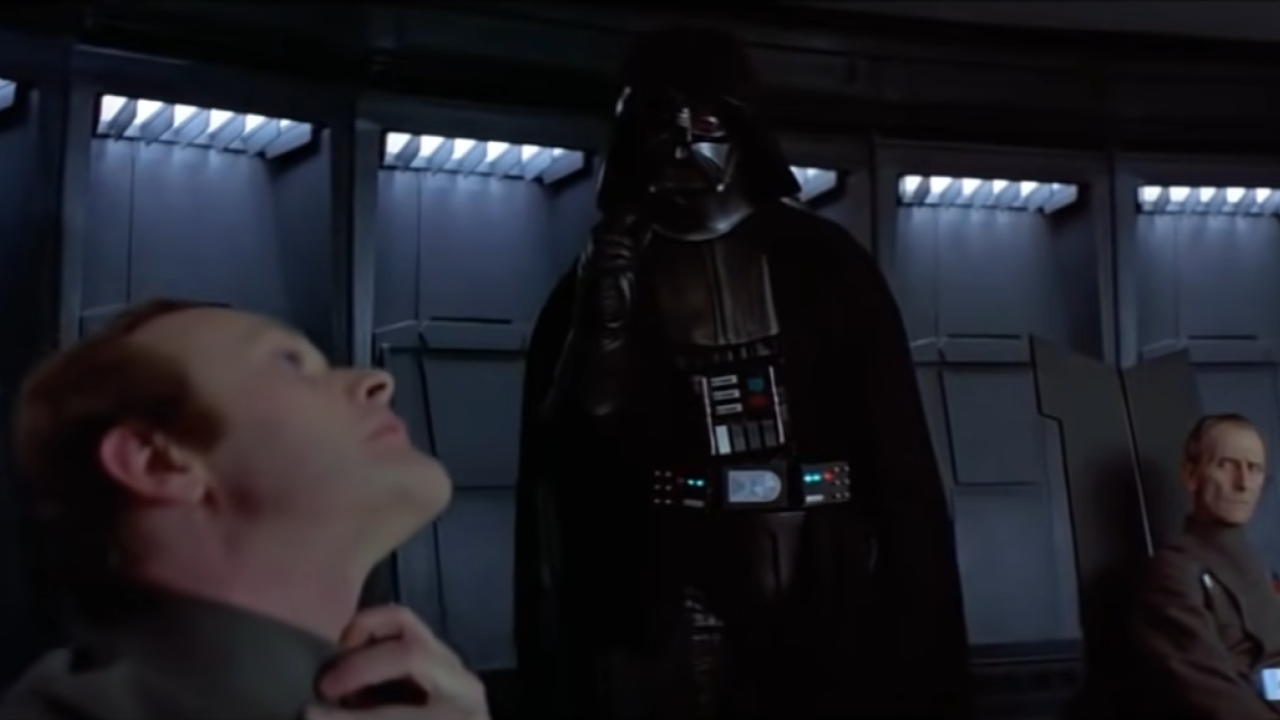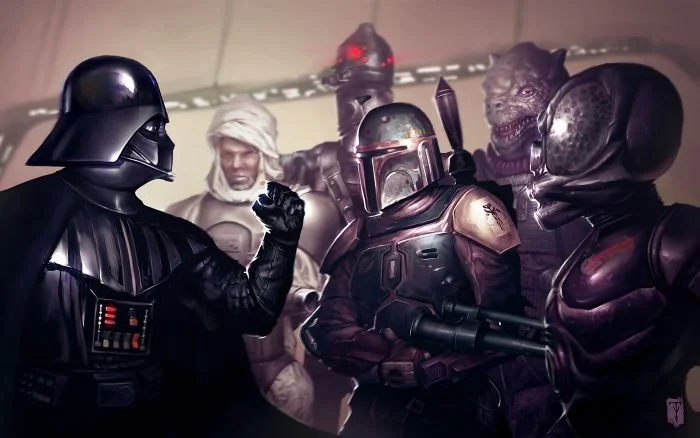Why The Imperials In 'Star Wars' Didn't Respect Or Fear Darth Vader As Much As They Should Have
We have all recognized Darth Vader’s magnificence in the Star Wars universe. He is the Emperor’s apprentice, a Sith Lord, a powerful Force user, a military leader, and, simply, a badass. However, when we first meet him in A New Hope, he is curiously placed in their hierarchy. He seems to be Grand Moff Tarkin’s lackey and regarded indifferently by the Empire’s officers. There is that iconic scene in A New Hope where Vader informs the fleet brass that they will soon recover the lost Death Star plans. Admiral Motti suggests using the Death Star as an example of the Empire’s power, at which point Vader rebukes him about putting too much faith in technology, and suggests it pales in comparison to the power of the Force.
“Don't try to frighten us with your sorcerer's ways, Lord Vader,” Admiral Motti says. “Your sad devotion to that ancient religion has not helped you conjure up the stolen data tapes, or given you clairvoyance enough to find the Rebels' hidden fort …”
RELATED: Darth Vader vs. Grand Moff Tarkin
Vader then Force-chokes him. The rest of the brass watches in awe. Only Grand Moff Tarkin speaks with any authority when he orders Vader to release Motti.
This scene demonstrates the casual disregard towards Vader in A New Hope, but why are these the prevailing attitudes given how we all appreciate Darth Vader as the Big Bad? It is actually an interesting study between trilogies that provides this contrast.
In the prequel trilogy, the Jedi are well-known. We see that repeatedly. The Trade Federation regards the arrival of Qui-Gon Jinn and Obi-Wan Kenobi with reverence. The Jedi advise the Republic, negotiate their disputes, and mete out justice. It is, for the want of a better term, a time of magic and an age of wonders.
You see that even in engineering and architecture. The Nubian starship that Qui-Gon and Obi-Wan use in The Phantom Menace is gorgeous. Coruscant is a planet of towering skyscrapers. It is an idyllic manifestation of a civilization full of riches. There is time for luxury and beauty and freedom of expression. That is the galaxy we see.
As the prequel trilogy goes on, the story systematically eradicates the individualism of the Republic and enters a period of industrialization. We get the clones as the prototype of the stormtroopers who are essentially the same soldier in the same uniform. The Republic builds a fleet of the same utilitarian ships. It is a time of standardization as one man impresses his tyranny upon the galaxy. The prequel trilogy ends with the fall of everything we were introduced to at the beginning of the story.
All this happens due to the rise of the Sith – Palpatine and Darth Vader, and Vader’s predecessors in Darth Tyranus, and Darth Maul. Nobody else could topple the Jedi. Nobody else could manipulate the Senate. Nobody else could usurp the Republic. Nobody else had the vision or the ambition or the courage to orchestrate such a coup. The only other opposition we see is from the Trade Federation (although they are being manipulated by Palpatine), and they are not taken seriously. When Qui-Gon and Obi-Wan go to meet them at the beginning of The Phantom Menace, Qui-Gon remarks that negotiations will be “short.” He is entirely dismissive of them.
However, once the Empire has been launched, it is a time of militarization, brute force, and the weight of numbers. While the Emperor would still employ Vader for special duties (such as hunting the Jedi), the mandate now is to establish a military stranglehold upon the galaxy. That means fleets and soldiers, which are things that people can immediately recognize, respect, and fear.
It is little surprise that Vader fades more and more into the background as the Empire's influence and power grow. Although when A New Hope first debuted, there is the sense that the Empire was much older than it would later be qualified. It is unsurprising that as the military becomes the face of the Empire that Vader grows almost obsolete in the new hierarchy.
While he takes responsibility for tracking down the Death Star plans, it is obvious that Grand Moff Tarkin is now in charge. Tarkin commands the Death Star. Princess Leia is brought to him. He orders the attack on Alderaan. Vader only takes the initiative when he senses Obi-Wan Kenobi and decides to confront him. The Force is part of the universe he once knows. It has been absent from the Empire since they took over. It is also a personal grudge to be settled.
When the Rebels attack the Death Star, Vader seems to take it upon himself to help in its defense. Given how Vader is framed, you could imagine he almost does this to entertain himself since he is not active in any other way. This is Vader’s lot, a man out of his time and who arguably does not have the power or wit to overthrow Palpatine and become the Master in the Sith dichotomy. It is little wonder that others are indifferent to him. He is now a relic. Given the age profile of everybody but Grand Moff Tarkin in A New Hope, it is doubtful anybody was around to witness Vader’s heyday or truly understand who or what he is, or what the Force is and how powerful it is.
Come The Empire Strikes Back, the Emperor’s focus is no longer on the Rebels. They always seem relatively insignificant to the Emperor, if not a plaything. His eyes are on Luke Skywalker. Both the Emperor and Darth Vader identify his potential with the Force and the threat that this single individual could pose to them. Capturing and converting Luke takes priority.
Once this becomes evident, Vader returns to prominence. Naturally, he does things to validate this standing, such as Force-choking officers who have failed him. However, he now has a reason to reassert his authority, earn the reverence and dread of his subordinates, and become the Darth Vader who strikes terror in all who encounter him.
READ NEXT: New 'Star Wars' Project With Bizarre Title Apparently In The Works




